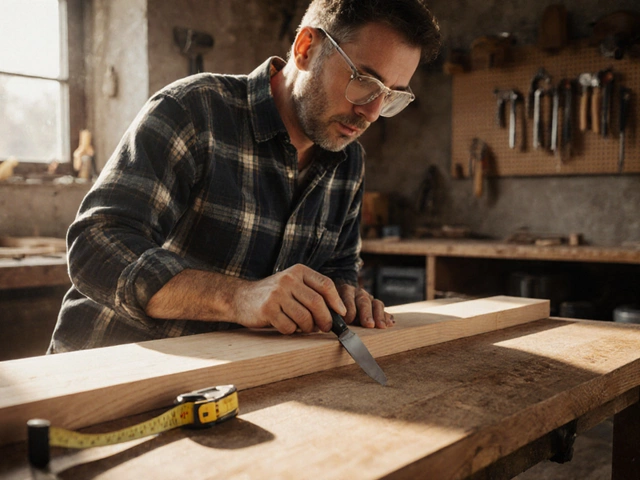Ever thought about tackling a home project, only to be stopped by the looming question: where do I even start? Diving into construction can be as intimidating as it is thrilling, especially without a formal background. But guess what? You can totally teach yourself construction—and it can even be fun. Imagine creating a space or fixing something up and knowing that you did it all. Let's get started on making that idea a reality.
First off, understanding the basics of construction is like getting your driver's license before hitting the road. You don't need to master everything right away. Learn about materials, tools, and the basic principles of construction. YouTube can be your best friend for this. With a gazillion how-tos available, start with small, manageable projects to build confidence and skills.
- Understanding the Basics
- Finding the Right Resources
- Hands-On Practice
- Learning from Mistakes
- Safety First
- Networking and Community
Understanding the Basics
So, you're all set to jump into the world of construction? That's awesome! Let's start with some basics that are super important to get you feeling comfortable and ready to tackle any project. First things first, you'll need to know your way around materials like wood, metal, and concrete. Each one acts differently—you wouldn't hammer a nail into concrete, right? Understanding material properties helps you choose the right one for the job.
Next up, tools! You don't need a full workshop to begin, but having a trusty hammer, tape measure, and a good drill is key. Each tool has its purpose, and knowing when and how to use them is crucial. YouTube is packed with tutorials showing how different tools work, so take advantage of that.
If you're dreaming about building something from scratch, like furniture or even a tiny house, you'll also need to wrap your head around some design basics. Sketching out your plans, even in a simple notebook, helps you avoid mistakes. Think about the saying, "measure twice, cut once." Saves time, money, and frustration.
Don't forget about building codes and permits, an often overlooked part of construction. Depending on where you live, you'll need to follow local regulations to ensure your work is safe and legal. It's not as exciting as swinging a hammer, but trust me, it's necessary.
You'll also hear a lot about safety. It's important not to skip over this part. Safety goggles, gloves, and other personal protective equipment (PPE) can seem like overkill, but they're there to prevent injuries. Makes a world of difference when you're working with power tools or hazardous materials.
Here's a quick cheat sheet to help you get started:
- Learn about different construction materials and their uses.
- Familiarize yourself with basic tools and their functions.
- Develop a habit of planning and sketching before starting a project.
- Understand and adhere to local building codes and permits.
- Always prioritize safety and use the right protective gear.
Once you've got these fundamentals down, you're on your way to approaching more complex projects with confidence. Remember, self-learning does take a bit of patience, but the payoff is totally worth it.
Finding the Right Resources
Okay, you've decided to dive into the world of self-learn construction, but where do you go for the how-tos? Thankfully, with today's technology, there’s a wealth of resources that can guide you every step of the way.
First stop: the internet. Websites like DIYNetwork and Family Handyman are perfect starting points. They offer tons of step-by-step guides and expert advice on everything from basic repairs to more complex builds. Don't forget YouTube—it’s packed with tutorials that can show you exactly how to use different construction tools and materials.
Want something more structured? Consider online courses on platforms like Coursera or Skillshare. These can provide a more formal approach, covering the basics of construction, tool safety, and project management. Some courses even offer certifications, which is great if you’re thinking long-term.
Books can be useful, too, especially those that cover fundamentals and techniques. Popular titles like “The Complete Do-It-Yourself Manual” by the Editors of Family Handyman or “Ultimate Guide: Home Repair and Improvement” can be invaluable on your bookshelf, full of insights and tips from pros who've been in the industry for decades.
Don't underestimate the power of community learning, either. Join forums like Reddit's DIY or ContractorTalk. These spaces allow you to connect with others who share your goal, and experienced builders often pop in to share their wisdom and answer questions. Plus, you can learn from the successes and mistakes of others.
Here's a quick rundown of where to look for these resources:
- DIY websites and blogs
- YouTube channels dedicated to DIY construction
- Online courses on platforms like Coursera and Skillshare
- Books from experienced authors in construction
- Online forums and communities
With these resources at your disposal, you're on your way to becoming a self-taught construction whiz in no time. Just take it one project at a time, and remember: it's all about learning as you go!
Hands-On Practice
Learning by doing is the secret sauce to mastering self-learn construction. Once you’ve gotten a grip on the basics, it’s time to roll up your sleeves and get your hands dirty. Starting with small projects helps build confidence. Think painting a room, fixing a leaky faucet, or building a simple bookshelf. These tasks not only hone your skills but also boost your problem-solving abilities.
Before diving into bigger projects, make sure you’re comfortable with your tools. While watching tutorial videos is great, nothing beats the real deal—holding a hammer, drilling into wood, or cutting tiles yourself. The trick is to practice regularly. Like any skill, the more you do it, the better you get.
Here’s a quick tip: keep a journal or a blog about your projects. Jot down what you did, what went wrong, and how you fixed it. This helps in tracking progress and can be a goldmine of lessons for future projects.
- Start small, aim for something you can complete in a weekend.
- Use scrap materials for experiments.
- If possible, shadow a friend or a family member who knows their way around tools.
Learning from past projects can save you a ton of time and frustration. Speaking of which, always pause to reflect. After completing a project, assess what you learned, and don’t shy away from asking for feedback.
And remember, safety isn’t something to take lightly. Wear your goggles, gloves, and sometimes even a hard hat, depending on the task. If you can, take a basic safety course. That way, you ensure that your newfound passion for construction doesn’t unexpectedly turn into a trip to the ER.

Learning from Mistakes
Embarking on the journey to self-learn construction means you're bound to hit a few bumps. It’s like learning to ride a bike; you’ll definitely wobble before you win the race. The key is not in avoiding mistakes but in learning from them. This process is what shapes your skills and boosts your confidence over time.
When something doesn’t go as planned, it’s crucial to pause and dissect what happened. Was it the wrong choice of materials? Did you not measure correctly? Ask questions and seek solutions. Using a construction journal is a great way to track your progress and jot down what went south, along with possible fixes for next time. It becomes your personal guidebook, tailored from your experiences.
- Reflect on what led to the mistake and identify alternative approaches for future projects.
- Seek advice from online forums or communities, like Reddit's DIY group, to gain different perspectives.
- Try to recreate the situation in a safe environment to experiment with different solutions until you crack it.
The most seasoned builders didn’t get everything right on the first try. Even professional construction workers keep learning and adapting. They rely on a core set of skills honed through trial and error. By allowing yourself to make these errors, you open the door to understanding the nuances of construction deeply.
If you dwell too much on perfection, you might miss the creativity that DIY construction demands. Accept the imperfect projects as learning milestones rather than failures. And remember, a mistake is only a failure if you don’t learn from it.
Safety First
Jumping into construction without thinking about safety is like driving blindfolded. It's crucial to stay safe, especially when you're learning construction skills on your own. Accidents can happen, but being prepared makes all the difference.
First things first, gear up. Invest in good quality safety equipment. This includes a hard hat, safety glasses, ear protection, and steel-toe boots. Sure, these items might seem like a big buy upfront, but think of them as insurance. They're protecting you from injury, and that's priceless.
Next, get familiar with the tools. Before using any tool, read the manual. Seriously, those boring booklets hold lifesaving info. For power tools, double-check the safety features, like blade guards or emergency stop buttons. And never forget: unplug tools when they're not in use. A friend once told me about an electric saw accident they avoided by this very step!
Let's talk about ladders. Doesn't seem dangerous, right? But falls are a leading cause of injury on construction sites. Always ensure the ladder is on a stable, even surface and follow the 'three-point rule'—always keep three points of contact on the ladder (two hands and one foot, or two feet and one hand). Don't reach too far; move the ladder instead.
It's also vital to have a basic knowledge of first aid. You might not need to become a full-fledged medic, but knowing how to treat cuts, scrapes, or even a sprain can be a lifesaver. Quick tip: keep a stocked first-aid kit handy in your workspace.
Now, let's sprinkle some stats. According to a 2023 study by the Home Construction Safety Association, 78% of DIY builders reported that wearing proper protective gear prevented severe injuries in minor accidents. Here's a snapshot of common safety equipment usage:
| Equipment | Usage Rate |
|---|---|
| Hard Hat | 85% |
| Safety Glasses | 80% |
| Ear Protection | 72% |
| Steel-Toe Boots | 90% |
Remember, safety isn't just about protecting yourself. It's about being respectful of your environment and those around you. If you're working at home, keep kids and pets away from your work area to prevent accidents.
Just like having a backup plan is key in life, having a safety-first mindset in DIY construction ensures you're ready for any unexpected twists. Keep safety top of mind so you can focus on the thrill of building something amazing.
Networking and Community
So you're diving into the world of DIY construction. Great! But even if you're learning at home, it doesn't mean you have to go it alone. The construction community is surprisingly welcoming and full of folks eager to share their knowledge. Getting plugged into this network can fast-track your self-learning journey.
Where to start? Online forums and groups are gold mines. Websites like Reddit and specialized forums like DIY Chatroom have entire communities built around sharing advice, troubleshooting problems, and celebrating successes in construction projects. Engaging in these spaces not only gives you answers to questions you might have but also connects you with people who have likely faced similar challenges.
If you're more of an in-person kind of person, consider local workshops or meetups. Sometimes home improvement stores like Home Depot offer free classes on a range of construction skills. It’s a no-brainer way to pick up new tricks and meet fellow enthusiasts in your area.
Also, don't underestimate the power of social media. Instagram and Pinterest are filled with DIY creators who document their projects. Following them can provide inspiration and motivate you to reach out with questions or comments. You might even find a mentor willing to guide your journey.
Connecting with a community doesn't just help with immediate questions or projects. It builds a network of support and inspiration that can be invaluable as you tackle larger and more complex DIY construction projects. So go ahead, dive in, and see how much you can gain from the shared wisdom of other learners and professionals.





Write a comment